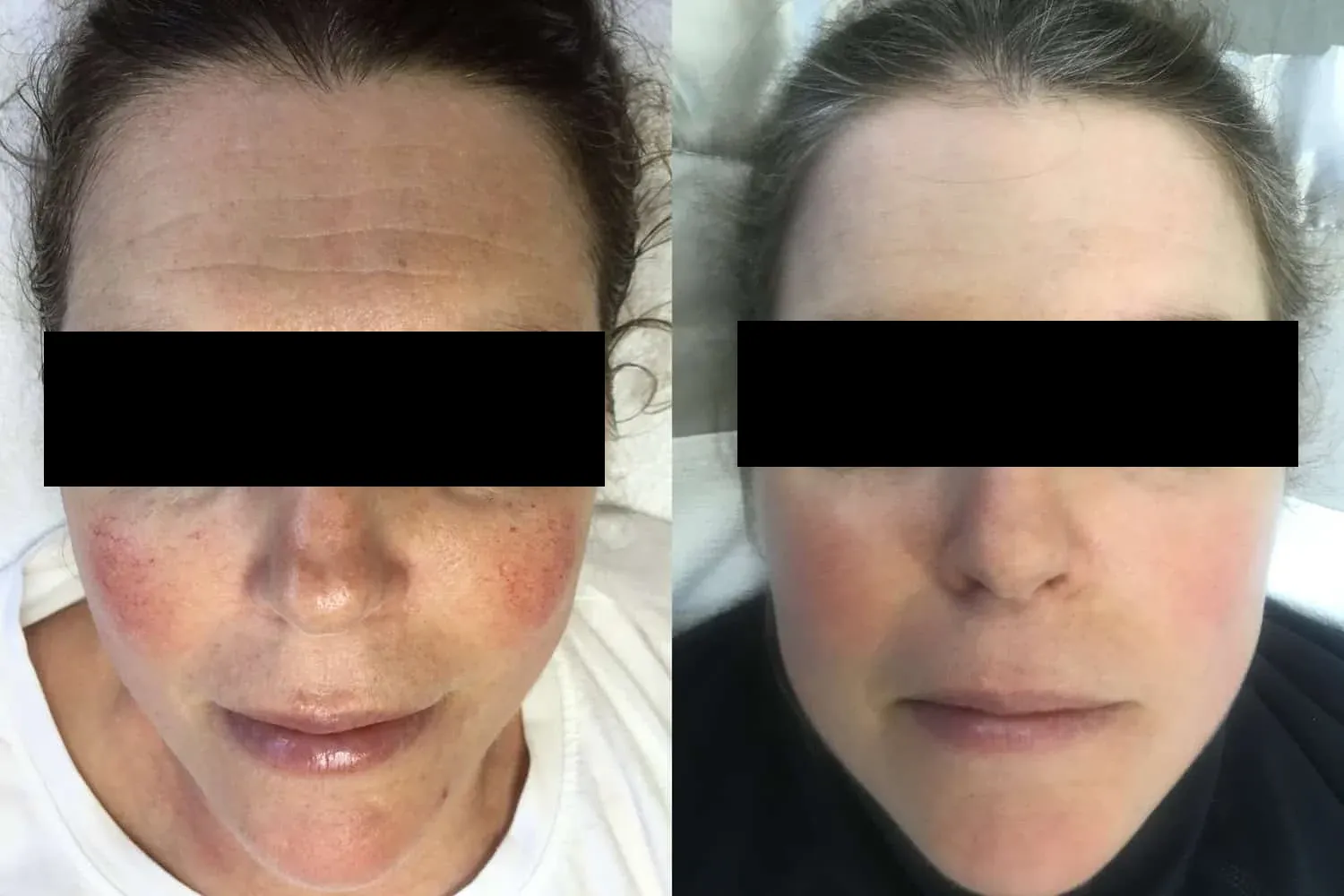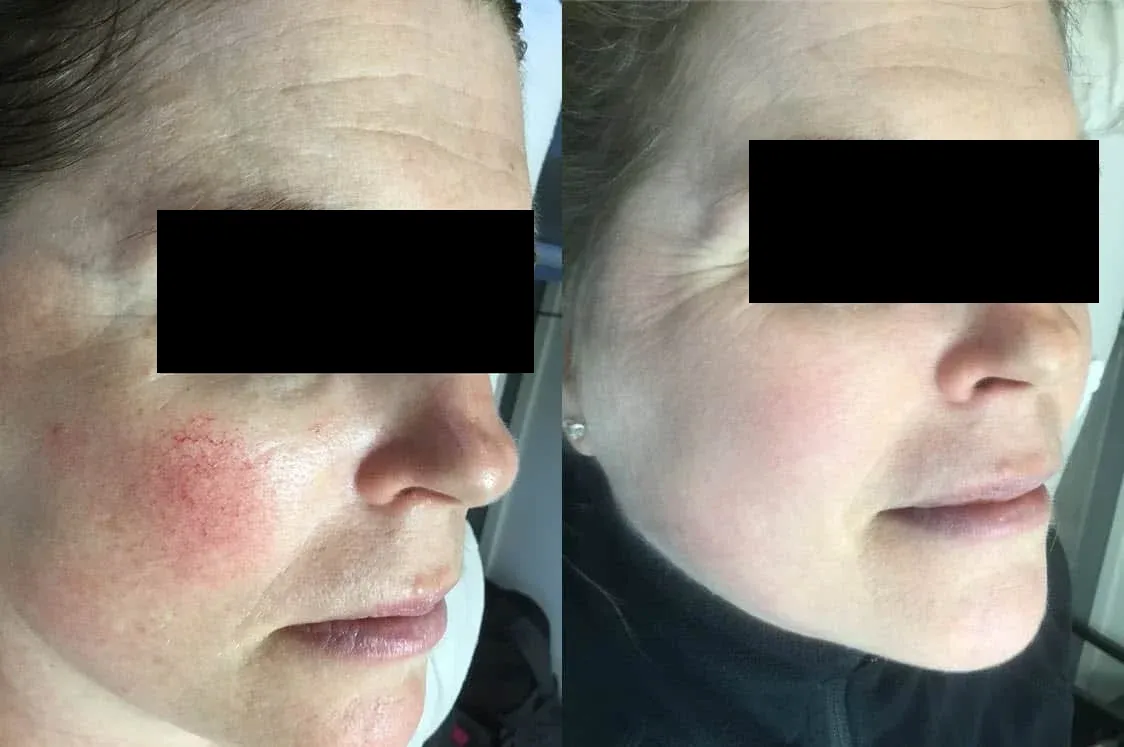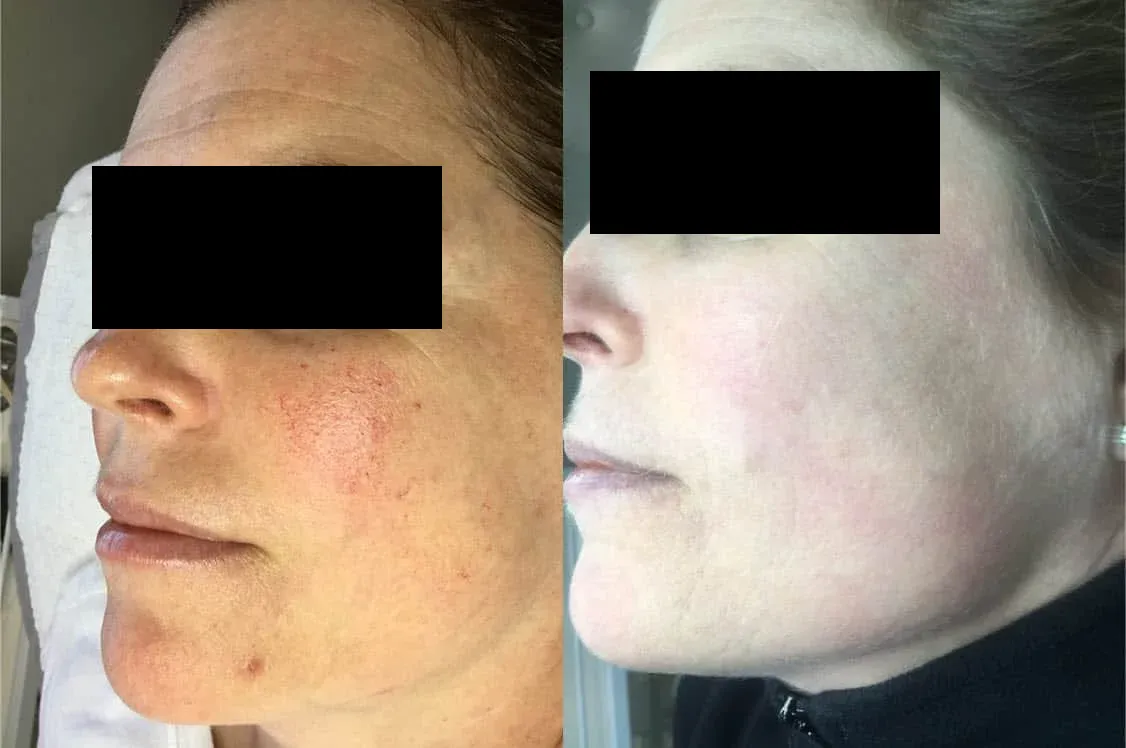Rosacea and Facial Redness – Causes, Removal and Treatment – Auckland NZ
Rosacea or facial redness is a chronic skin condition that causes flushing or redness on the face accompanied by slight swelling and a burning sensation. Our skin and vein experts at Palm Clinic, Auckland NZ can recommend a holistic approach to rosacea treatment including modern laser treatment and advanced skincare products that reduce and remove facial redness.
Below you can read about rosacea and facial redness causes, symptoms, treatment and view our before and after rosacea pictures.

- Aesthetic Concerns
- Ageing
- Frown Lines
- Bags Under Eyes
- Drooping Eyes
- Crow’s Feet
- Sagging Face
- Loss of Facial Definition
- Thinning Lips
- Upper Lip Lines
- Bulging Arm Veins
- Skin
- Skin Pigmentation
- Rosacea / Facial Redness
- Acne Scarring
- Moles and Skin Tags
- Dull Skin
- Sweat
- Excessive Sweating
- Fat Pockets
- Abdomen
- Thighs
- Ankles
- Arms
What Causes Rosacea and Facial Redness?
Rosacea symptoms typically affect people with fair skin and blue eyes between the ages of 30 and 60. Men seeking rosacea treatment also often suffer from rhinophyma, which is the thickening of the skin on the nose making it swollen and bulbous.
Rosacea symptoms include:
- Persistent redness on the cheeks
- Diffuse redness on neck
- Redness on nose
- Visible blood vessels (broken capillaries) on face
- Red spots or areas on the face with associated
- Swelling and/or scaling of the skin
- Raised red lumps or even pustules that resemble acne
- Aggravation by spicy food, emotional stress, alcohol and exercise
- Reactive, sensitive skin that is irritated by make-up and skin creams and oils
- Red, irritated, tired eyes that are prone to styes (ocular rosacea)
- Swollen and thickened skin which can affect the cheeks and nose (rhinophyma)
Rosacea symptoms are triggered by an exaggerated immune response in the skin, which causes dilation of blood vessels, growth of new blood vessels, swelling in the skin and tissue remodelling causing thickened skin.
There are multiple factors that can cause rosacea including environmental factors such as sun exposure and UV damage, genetic factors such as being of Celtic origin, and vascular and inflammatory components. Facial creams, oils and topical steroids can also exacerbate facial redness.
Rosacea and Facial Redness Removal and Treatment
One of the major recent advancements in facial redness treatment has been Pulsed Polychromatic Light (PPL) – a light based treatment that is highly effective and requires minimal down time. PPL can reduce the following rosacea symptoms:
- Telangiectasia or dilation of blood vessels
- Facial erythema or persistent redness
- Flushing
- Papular and pustular lesions
- Sensitive skin with a tendency to skin irritation
PPL works deep inside the skin by targeting visible blood vessels associated with rosacea. Alongside a visible reduction in facial redness, PPL stimulates collagen production and the growth of new skin cells to create an overall rejuvenation of the skin.
Our expert skin therapist can help maintain the best results with medical grade rosacea skin care, a specific rosacea cream, as well as medi-facials and chemical peels to keep your skin healthy and resistant to skin irritation. You can book a complimentary skincare consultation with her to find out which products can help relieve your rosacea symptoms.
She will also advise on general measures that you can take at home to control your facial redness.
These include:
- Avoiding creams, oils, spicy foods, alcohol or whatever environmental factors exacerbate your rosacea
- Using water based rather than creamy or oily skin care, make-up and sunscreen
- Avoid applying steroid creams to your rosacea. It will calm it initially, but make it worse in the longer term
- Protect your face from sun exposure with a hat and by using water based SPF
- Your Palm Clinic doctor may prescribe an oral antibiotic, topical antibiotics (only when necessary) or azelaic acid for resistant cases, particularly if you have pustules present
Facial Redness and Rosacea Before and After Treatment
You can see more examples of rosacea pictures here, both before, and after treatment. Individual results may vary.





Light treatment effectively reduces broken veins/rosacea. Individual results may vary.
FAQ
Causes of rosacea are not well known. Rosacea is often considered a hereditary condition. It is also said that rosacea is likely to occur in people who blush a lot. Occurrence of rosacea can be associated with environmental, chemical, food or emotional triggers. Common triggers include exposure to extreme heat and cold weather, hot beverages and spicy foods, and alcohol consumption. As a large number of hair follicle mites (Demodex folliculorum) are found in rosacea papules, they are also a possible cause of rosacea. The stomach bacterium helicobacter pylori is also reported to be associated with rosacea, though most dermatologists disagree with this theory. Rosacea may worsen with the use of facial creams, oils and topical steroids.
- Redness on the face, particularly the cheeks, nose, chin and forehead.
- Small red lines beneath the skin due to the thickening of blood vessels (telangiectasia).
- Skin becomes thicker, particularly over the nose.
- Hard raised lesions (papules) and pus filled acne pimples (pustules) develop on the reddened facial skin.
- Inflammation in the eyes causing a burning or stinging feeling.
- Irritation in the eyes, watery eyes, sensitivity to light and sometimes blurred vision.
- In advanced cases, the nose becomes larger and swollen with thickened skin causing a rhinophyma.
Rosacea-subtypes:
There are 4 sub-types of rosacea.
- Erythematotelangiectatic rosacea marked by flushing and redness.
- Papulopustular rosacea with papules and pustules and burning and stinging sensation.
- Phymatous rosacea characterised by thickening skin and enlargement as in rhinophyma.
- Ocular rosacea marked by ocular changes like conjunctivitis, telangiectasis of the conjunctiva and inflammation of the eyelids.
There are four acknowledged stages of rosacea.
- First stage is called pre-rosacea characterised by facial blushing which may begin in early childhood, though the condition of rosacea sets in after the thirties. Frequency of flushing may increase and experience of burning and stinging when using antiacne products or cosmetics may be common.
- In the second stage which is vascular, redness (facial erythema) and thickening of the blood vessels and their visibility on the skin as small red lines (telangiectasis) develop.
- In the third stage facial erythema and telangiectasis increase with the formation of papules and pustules. In this stage changes in the eye (ocular changes) like inflammation of the eyelids and watering of the eyes begin to occur.
- In the fourth stage, the skin and eye inflammation increase to a great extent. In very rare and severe cases ocular inflammation can lead to loss of vision whilst fibroplasia and sebaceous hyperplasia of the skin lead to rhinophyma.
It can lead to frustration due to the unattractive appearance and the discomfort experienced. It can mar the personal, social and professional life of the individual. In extreme cases the psychological effects of such a condition can be very serious and can cause the patients to become reclusive. Rosacea is primarily a facial occurrence and develops gradually. In its initial stages, patients often mistake the facial flushing, papules and pustules for adult acne, sun burn or normal signs of ageing.
There is no cure for rosacea. But there are various rosacea treatments to control rosacea effectively. Your Palm Clinic doctor will determine a treatment plan for you depending on the extent of damage to the skin. PPL and laser treatments are most useful for the facial redness and flushing.
The first line of treatment for the pustules associated with rosacea is often topical or oral antibiotics generally prescribed by the family doctor. Metronidazole (Rosex) is generally given as a topical antibiotic. Oral medications include tetracycline antibiotics like tetracycline, doxycycline and minocycline. The antibiotic rosacea gel or rosacea cream should be applied on the entire face instead of on the lesion spots alone.
The eyelids should be cleaned everyday with a diluted baby shampoo or a rosacea cleanser for the eyelids. Warm compresses should be applied on the eyelids a few times a day.
For treatment of rosacea in the advanced stages like rhinophyma, laser or radiofrequency surgery is the ideal method to remove the excess tissue on the nose.
- Improves appearance.
- Boosts self confidence and self-esteem.
- Long-lasting results.
- Few or no side-effects.
